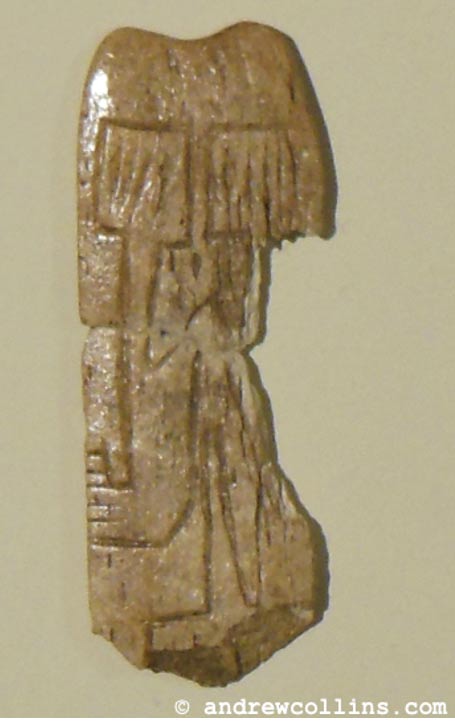
Andrew Collins*
Abstract: A tiny bone plaque found at the Pre-Pottery Neolithic site of Göbekli Tepe in southeast Turkey, and currently on display in nearby Sanliurfa Museum, shows the first recorded depiction of the site's familiar T-shaped pillars. In addition to this, the etching on its surface might well be the earliest known use of a 3D perspective in prehistoric art. The plaque's finely carved imagery also reignites the debate over the axial orientation of the site's main enclosures and any potential astronomical targets during the epoch of their construction.
Key words: Göbekli Tepe, Sanliurfa Museum, bone plaque, soul holes, megalithic architecture, Cygnus, Deneb, Orion, Sirius (Alpha Canis Majoris.
It was found during routine
excavations at the 11,500-year-old site of Göbekli Tepe in southeast Turkey,
but no one had recognised exactly what the carved lines on the small bone plaque
showed. This was until Matthew Smith, a British telecommunications consultant
living in Qatar, visited Sanliurfa Museum, which houses a large collection of
portable objects found at the Pre-Pottery Neolithic (PPN) site of Göbekli
Tepe, located around 8 miles (13 kilometres) away to the northeast. Smith recognised
something that everyone else appears to have missed, this being that the little
plaque - just 6 cm in length, 2.5 cm in width and 3-4 mm in thickness - bears
on its upper surface two T-shaped features positioned side by side (see fig. 1).
The context of the plaque's discovery, i.e. at Göbekli Tepe, makes it clear
these T-like etchings are pictorial representations of the familiar T-shaped pillars
found in all the key enclosures uncovered at the site.

Fig. 1. The tiny bone plaque found at Göbekli Tepe and now on display at Sanliurfa's new archaeological museum (picture credit: Andrew Collins).
The carved images of T-pillars on the bone plaque are so minute it is possible that no one else has correctly identified what it shows (certainly, nothing to date has appeared in print). Indeed, the exact nature of the plaque's highly significant carved art was missed by the present writer, who was alongside Matthew Smith when he made this extraordinary breakthrough in our understanding of the unique mindset of the Pre-Pottery Neolithic culture behind the construction of Göbekli Tepe.
Twin Central Pillars
So what exactly does the tiny bone plaque represent? That its T-pillars are displayed side by side, their heads clearly visible, implies they signify twin pillars like those placed at the centre of all the major enclosures at Göbekli Tepe. Some of these twin monoliths, like those in Enclosures C and D, were originally up to 5 metres in height and weighed as much as 15 to 20 tonnes a piece (see fig. 2).
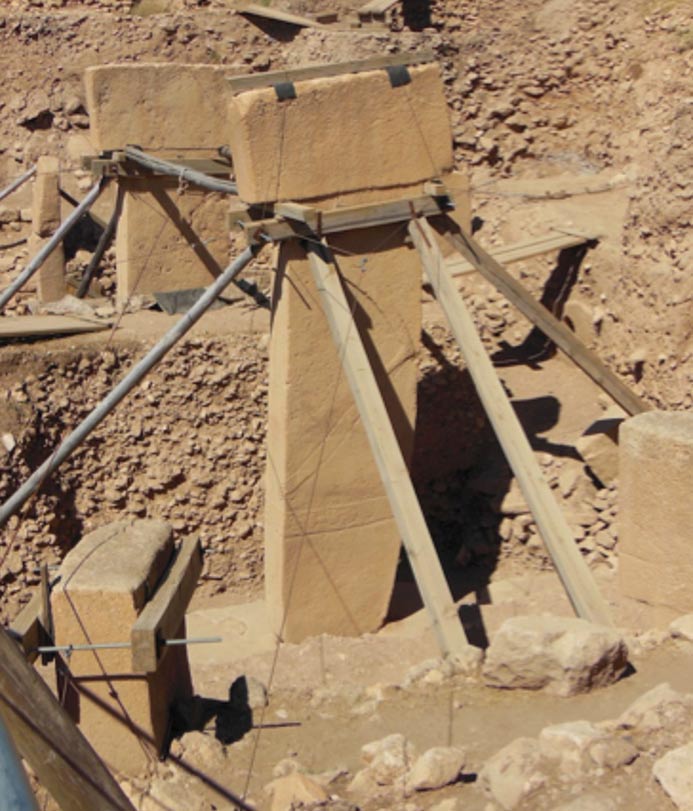
Fig. 2. The twin central pillars in Göbekli Tepe's Enclosure D (picture credit: Andrew Collins).
Although these twin central pillars have always been found to be edge on towards the entrant when approaching from the south, the artist responsible for the plaque's carving has most likely depicted the pillars sideways on to ensure the viewer knows exactly what is being seen. There could, of course, be an enclosure still to be uncovered where the central pillars are turned this way, something found to have been the case at the PPN site of Çayonu, north of Diyarbakir. Here twin stone slabs, which do not appear to have had T-shaped terminations, were erected edge on to each other at the centre of two out of three of its cult buildings (Ozdogan & Ozdogan,1989).
Exactly which enclosure is depicted on the plaque might never be known. Although nine major enclosures have so far been investigated at Göbekli Tepe (designated A, B, C, D, E, F, G, H and the Lion Pillar Building), radar and geophysical surveys carried out at the site in 2004 indicate that as many as 20 more structures of a similar size and complexity await discovery. These lie beneath the site's 300 x 200 metre occupational mound, constructed over a period of some 1,500 years before the site's final abandonment in around 8000 BC. Any one of these enclosures could be illustrated on the plaque. Compounding the matter of identifying the exact enclosure depicted is the fact that the plaque may not have been found at its place of manufacture. Earth, rubble, stone chippings and human debris were constantly moved about during Göbekli Tepe's occupation to act as infill for those enclosures no longer in use. In other words, it could have come from anywhere on the site, or possibly even from another PPN site altogether (although this last suggestion does seem unlikely).
Ancient Talisman
Another important question is how the bone plaque came to be made and what its purpose might have been. Even though it bears no holes indicating its use as a pendant, it could still have functioned as an amulet or talisman. Capturing the likeness of the twin central monoliths in one of the enclosures at Göbekli Tepe was perhaps thought to imbue the bone plaque with a mystical quality in order to connect it with the site. Moslem pilgrims on the hajj pilgrimage to Mecca buy pendants showing the Kaaba, the square-shaped building at the heart of the religious sanctuary. These are considered to bestow good luck on the owner. Arguably the bone plaque was created with a similar purpose in mind.
3D Perspective
Yet the plaque's importance as the first recorded pictorial representation of T-shaped pillars at Göbekli Tepe is just the beginning. A more detailed examination of its carved imagery shows various other truly remarkable features. For instance, its apparent use of a three dimensional perspective is more of less unique in prehistoric art from this period. This is displayed about halfway down the right-hand edge of the left pillar. Here a line rises at an angle towards the centre of the image. This rising line appears to depict a retaining wall linking the pillar with an inner area of the enclosure. At Göbekli Tepe the pillars making up the stone circles that surround the twin central monoliths are set within retaining walls, their blocks held together by a light mortar.
Centrally placed below the plaque's twin pillars is what looks like a pedestal, from which rise two lines that converge at the centre of the plaque. Visually, these convey the impression of a walkway leading into the enclosure with the lines converging through the process of parallax, another example of the use of a 3D perspective.
Multi-layered Imagery
Just as
intriguing is the fact that the convergence of various lines between the T-pillars
gives the impression of a long-legged, abstract stickman standing either between
or in front of the stones (see fig. 3a). This does not appear to be coincidence,
implying a multi-layered interpretation of the carved imagery, something already
noted in the prehistoric art of southeast Anatolia's PPN culture.
For instance,
at Nevali Çori, a PPN site excavated in the 1980s and early 1990s at the
extreme north of Sanliurfa province, a life size human head in stone was found
with its face sliced off. It has a completely shaven head, save for a long tuft
or lock of hair, similar to the sikha sported by Hindu priests. Yet in addition
to acting as a stylised ponytail, the curled tuft doubles up as a rising snake
with a crescent-shaped head that has an uncanny resemblance to the cap and stalk
of a Psilocybin-like mushroom. Similar multi-layered symbolism seems to occur
on the bone plaque.
It
should be noted also how the main lines on the plaque seem to converge on the
deep peck mark positioned centrally beneath the heads of the T-pillars (see fig.
3b), emphasizing the hole's importance. This very distinctive peck mark appears
to have vertical lines either side of it, creating the likeness of the holed standing
stone positioned in the NNW section of the boundary wall in Enclosure D (see fig.
4).

Fig. 3. a) Outline view of the bone plaque's main features (picture credit: Rodney Hale). b) Overlay showing the plaque's main lines converging on the suspected holed stone (picture credit: Rodney Hale). Note the three peck marks above the T-pillars. Do they represent stars?
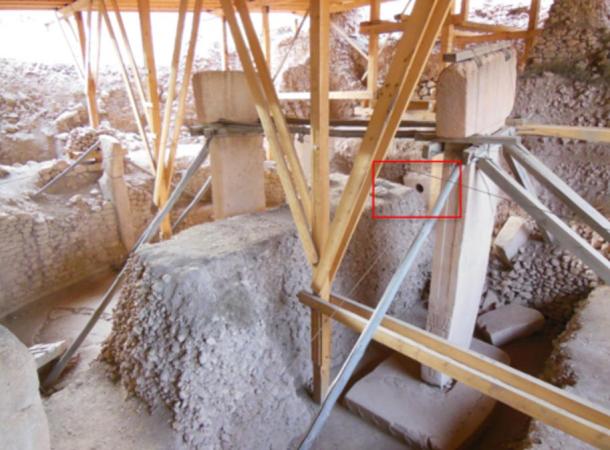
Fig
4. Göbekli Tepe's Enclosure D showing its holed stone (picture credit: Andrew
Collins).
A similar holed stone is seen in the NNW section of the outer boundary wall of Enclosure C. Yet this example (officially designated Pillar 59) has been turned on its side and is fractured across its circular aperture, due perhaps to the weight of the infill and rubble bearing down on it prior to excavation. An inner ring of stones, set within another retaining wall, was added to Enclosure C after its original construction (Schmidt, 2012, 141-42). This would have effectively blocked the line of sight between the twin central pillars and the holed stone.
In each case the holed stones (see figs. 5 & 6) would originally have been positioned to reflect the mean azimuth bearings of their twin central pillars. This suggests that these stones - their holes around 25-30 centimetres in diameter and bored through their widest faces - played key roles in the religious beliefs and practices of the Göbekli builders. Indeed, their positioning would indicate they acted in the capacity of the structure's altar or holy of holies, forming a bridge or point of connection between the liminal space created by the enclosure's interiors and the otherworldly realms and supernatural forces thought to exist beyond the physical world.
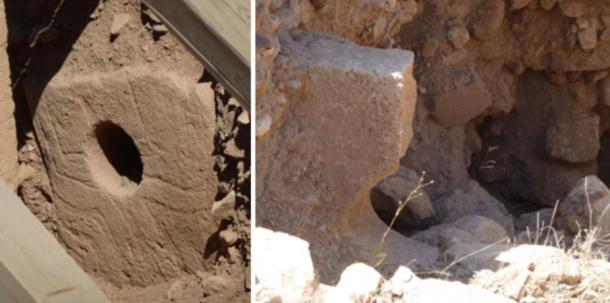
Figs. 5 & 6. Left, the holed stone in Enclosure D and, right, the broken example in Enclosure C (picture credit: Andrew Collins).
Soul Holes
Although the late Professor Klaus Schmidt, the head of excavations at Göbekli Tepe between 1995 and his untimely death in 2014, never commented on these holed stones seen in the two most accomplished enclosures uncovered to date, he did have something to say about the fragments of stone rings found at the site (one of which has been pieced together and is now on display at Sanliurfa Museum - see fig. 7). These, he suspected, had been placed in the walls of now lost enclosures and might have acted as seelenloch, a word in his native German language meaning "soul hole" (Schmidt, 2012, 99).
A large number of megalithic dolmens of Neolithic and later Bronze Age manufacture, from Ireland in the West across to India in the East, have circular apertures cut into their entrance stones (see fig. 8). Like the examples at Göbekli Tepe, these bored holes are usually between 25 and 40 centimetres in diameter, too small to allow a normal sized person to pass through bodily. Portholes in megalithic dolmens could have functioned as a means of offering food to the internee. Alternately, they might have enabled further human remains to be added, or, indeed, original interments to be removed. Such ideas, however, are inadequate to fully explain the widespread use of holes in funerary situations.

Fig. 7. Stone ring found at Göbekli Tepe and now in Sanliurfa museum (picture credit: Andrew Collins).
For example, in India circular portholes appear in stone slabs used as entrances to cist burials (Thapar, 2004, 95). Deliberately bored holes are seen also in ceramic urn jars found in cemeteries across Europe and Southwest Asia. These date to the Iron Age and later Roman times (Koster, 1983; Avetisian, 1999/2000). Apparently, the purpose of these holes was to provide a means for the release of the soul from its place of containment. In a similar manner, small doors or windows known as armen seelenloch, "poor soul holes," were once incorporated into the walls of houses in Austria. A number survive to this day, and there is no question that their primary function was to allow the exit of the soul following death, each one being opened only when there was a death in the household (Schwierz, 2011). Their existence has been linked with portholes identified as seelenloch in megalithic monuments located in the same region (Lukan, 1979, 55).

Fig. 8. The Nexis mountain dolmen near the town Gelendzhik in the Northwest Caucasus region of Russia showing its holed entrance façade (picture credit: Wiki Commons Agreement).
Until fairly recently, upon the death of a patient, nurses in rural areas of southern England would open the window nearest to the feet of a body in order that the soul might have a means of escape (personal communication to the author in 2014). Almost certainly the porthole stones at Göbekli Tepe served a similar function, although instead of the exiting souls being those of the deceased, it was the soul or spirit of the shaman or entrant that was thought to exit this world using the circular apertures.
Shamanistic practices in various parts of the world incorporate the idea of a symbolic hole, either in a rock, in the ground, within a tree, or in the roof of a yurt or tent, that enables the spirit of the shaman to leave its physical environment and enter the Upper or Lower World (Siikala, 1978, 145, 176, 194). Moreover, Siberian shamans are said to have employed the use of bones with holes in the middle to begin to "see all, and to know all" and that this "is when one becomes a shaman (Siikala 1978, 286)."
Perhaps the large peck mark centrally placed on the bone plaque found at Göbekli Tepe was considered a microform of the porthole stones seen in Enclosures C and D. The holder would thus focus his or her attention on this prominent peck mark in order to project their mind beyond the physical plane. In this way, they were able to "see all, and to know it all." So arguably the function of the bone plaque was to replicate ritual practices focused around the presence of the twin central pillars and porthole stones found in various key enclosures.
A Matter of Orientation
If correct, then the presence of the pecked hole between the twin pillars seen on the carved bone plaque strongly suggests that the entrant to the enclosures faced towards the porthole stones during rites and ceremonies. This strongly implies that the axial orientation of Enclosures C and D was thus NNW in line with the mean azimuth bearings of the twin central pillars. Indeed, if we look at Enclosure D (see fig. 9) we see that its holed stone is exactly placed with this purpose in mind. An examination of Enclosure C shows that its porthole stone (Pillar 59) would also have matched the mean azimuth of the structure's twin pillars before the stone was turned on its side.

Fig. 9. Plan of Göbekli Tepe's main enclosures showing their orientations (picture credit: Rodney Hale).
Some researchers of the ancient mysteries field have chosen to ignore this data and announce that the twin central pillars of key enclosures at Göbekli Tepe are aligned south, their twin central monoliths turned to face the rising of either the belt stars of Orion (Schoch, 2014, 54-55) or the bright star Sirius, (? CMa) (Magli, 2014). Both of these stellar targets have, however, been shown to be flawed (Collins, 2014, 77-80; Collins and Hale, 2014). What is more, the evidence available offers more compelling reasons for us to conclude that the key enclosures at Göbekli Tepe are oriented north, and not south.
Chartered engineer Rodney Hale, working with the present author, determined that the mean azimuth bearings of the twin central pillars in Enclosures B, C, D & E targeted the bright star Deneb (? Cyg) as it set on the NNW horizon during the epoch of their construction (Collins, 2014, 80-82, and see fig. 10). That the setting of Deneb helped determine the axial orientation of these enclosures is verified in a new study of Göbekli Tepe's astronomical alignments by Alessandro De Lorenzis and Vincenzo Orofino (2015).

Fig. 10. The alignment through the holed stone in Göbekli Tepe's Enclosure D towards the Cygnus star Deneb (picture credit: Rodney Hale).
The purpose of targeting a near-circumpolar star such as Deneb, located in the constellation of Cygnus, the celestial bird, was almost certainly to connect with the Milky Way, on which the asterism is prominently placed. In Eurasian folklore the Milky Way has long been seen as a road or river along which souls, often in the form of birds, journeyed to reach the afterlife (see fig. 11). For a full treatment of this subject see the author's work elsewhere (Collins, 2006).
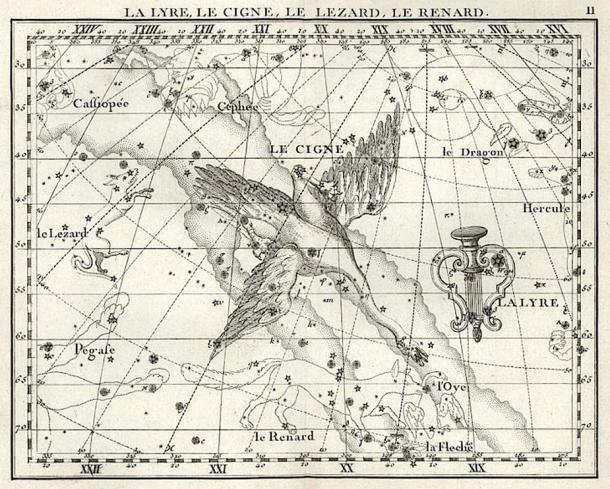
Fig. 11. The Cygnus constellation as the celestial swan flying along the Milky Way by English astronomer John Flamsteed (1646-1719).
The carved imagery on the bone plaque displayed at Sanliurfa Museum further supports a northerly orientation of the main enclosures at Göbekli Tepe. It implies that the entrant approaches the porthole stone, through which the setting of Deneb might have been watched during the epoch of their construction (Collins, 2014; Lorenzis & Orofino, 2015).
This conclusion is, however, challenged by journalist and ancient mysteries writer Graham Hancock. In Magicians of the Gods (2015) Hancock writes that the main enclosures at Göbekli Tepe are orientated south towards the stars of Orion and Sirius based on the findings of Schoch (2014, 54-5) and Magli (2014). Hancock acknowledges the proposed northerly alignments towards the setting of Deneb (Hancock, 2015, 304), and confirms their accuracy, but ultimately rejects them stating that a northerly orientation of the main enclosures is impossible. In his opinion "Enclosure D is built into the side of the steep ridge of the Tepe that rises to the north of the main group of enclosures." (Hancock, 2015, 331). Moreover, he writes that this ridge or slope seems natural (Email communication of 19 September, 2015). However, this is not the case. The whole occupational mound (or tepe), including its southern slope, is entirely artificial. It rises to a maximum height of 15 metres and was created to conceal existing enclosures built on the bedrock. It also provided level ground for the construction of further structures, which were themselves eventually buried beneath the gradually expanding mound (see fig. 12).
The main group of enclosures (A, B, C & D) exist in an excavated area cut into the southeast slope of the artificial hill, adding to the impression of a southerly orientation (see fig. 13). The geophysical survey of the mound in 2004 suggested that as many as 20 more structures await exploration. Many of these will have been built directly on to the bedrock at various locations beneath the tepe, and not simply at its southeast corner.
Adding to the popular belief that the main enclosures at Göbekli Tepe are oriented south is the fact that the relief carving on the twin central pillars in all enclosures faces south (with one exception - the eastern central pillar in Enclosure A faces north). This directionality includes the monoliths' anthropomorphic features, such as the crooked arms seen on their wide faces and the hands seen to reach around their front narrow edges. Thus it is assumed that the T-pillars, in their role as abstract statues, gaze out towards the stars that rise on the southern horizon. However, the entrances to these enclosures are located in the south, showing clearly that the entrant approaches the twin T-pillars from this direction, and thus faces north during their approach. This adds to the conclusion that the main enclosures face north, and not south.
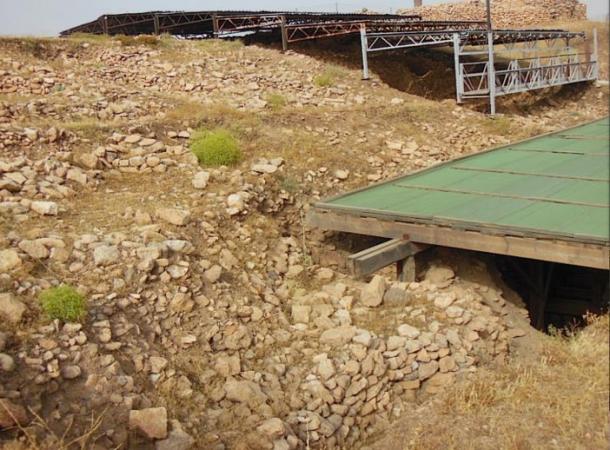
Fig.
12. The compacted infill behind Göbekli Tepe's Enclosure D. (picture credit:
Andrew Collins).
Core Mound Debate
That some kind of "core mound" of solid rock might exist at the centre of the occupational mound was originally proposed by Professor Klaus Schmidt (personal communication with the present author in September 2013). However, to date no physical evidence for this "core mound" has come to light. Indeed, the georadar survey of 2004 failed to map even the deepest enclosures, a fact admitted by Schmidt to Hancock in 2013 with the words, "… our geophysical mapping did not give us complete results and we cannot really see inside [the occupational mound]," (Hancock, 2015, 11). What is more, the spur located SSE of the hill ridge on which the tepe is located slopes very slightly downwards towards the north. This further supports the view that there would have been a clear view from the existing enclosures towards the northern horizon.
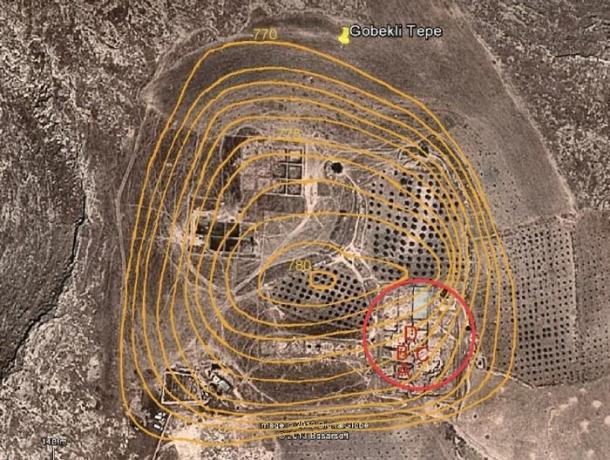
Fig. 13. Overhead image of Göbekli Tepe showing the position of main enclosures (A, B, C & D) overlaid with contours showing the height and extent of the occupational mound (picture credit: Google Earth/ DigitalGlobe/Rodney Hale).
Obviously, whether or not other features, such as earlier structures and monuments, might have impeded the view between the enclosures seen today and the northern horizon remains to be determined. This data will only come from future excavations. For the present, the tiny bone plaque is compelling evidence that those who entered Enclosures C and D during their heyday gazed beyond their twin central pillars towards the porthole stones in order to orientate their ritualistic activities. Here, towards the NNW, was to be found the entrance to the astral realms accessed during altered states of consciousness, as well as the supernatural forces seen perhaps as entering the physical world via the soul hole stones.

Fig. 14. The Göbekli Tepe bone plaque showing the three peck marks above the T-pillars, and the indentation at the base of the saddle back indentation at the top (pic credit: Rodney Hale/Andrew Collins/Hugh Newman).
Celestial Marks?
After a thorough examination of around 20 close up images of the bone plaque from two different sources (myself and my colleague Hugh Newman), Rodney Hale has been able to identify three deliberate peck marks that appear in a line directly above the T-pillars (see fig. 3b & 14). Their positioning in the "sky" suggests they might represent celestial objects. On the basis that the main enclosures at Göbekli Tepe (viz. B, C, D & E) have axial orientations that once targeted the setting of the bright star Deneb, Hale was able to determine that the three basic "wing" stars of Cygnus - Gienah, Sadr and Rukh - match very well the positioning of the three pecks marks. A suggestion that the peck marks might represent the belt stars of Orion was also checked, but quickly dismissed as the marks do not correspond with the positioning of the stars as they appear in the southern night sky - see fig. 15 where both sets of stars are compared with the peck marks. No similar peck mark exists for the position of the bright star Deneb, although a notch at the base of the saddleback indentation seen along the top edge of the plaque does correspond with the position of this star.

Fig.15.
Top, the belt stars of Orion during the epoch 9000 BC overlaid on the three peck
marks above the T-pillars on the Göbekli Tepe bone plaque and, bottom, the
wing stars of Cygnus overlaid on the same. It is clear that only the Cygnus stars
are a correct match (pic credit: Rodney Hale/Hugh Newman).
If the three peck marks above the T-pillars are taken to represent the three Cygnus wings stars (which they match perfectly), then the stars appear exactly as they should do in the night sky between their culmination and setting during the epoch 9000 BC (see fig. 16). Confirmation of this is that the stars' elevation (with the centre star Sadr at 45 degrees) means that the line of the local horizon passes through the middle of the deep peck mark representing the aperture of the porthole stone seen between the T-pillars. These porthole stones were, as we have seen, positioned in order that a person standing between the enclosure's twin central pillars could have watched the setting of Deneb through their circular apertures. This is further evidence that the bone plaque depicts the Cygnus wing stars in the epoch 9000 BC, and that the observational perspective of the plaque as drawn by the artist is undeniably towards the northwest.

Fig. 16. The northern night sky in the epoch 9000 BC superimposed on the Göbekli Tepe bone plaque. With the three Cygnus belt stars corresponding to the peck marks above the T-pillars the local horizon cuts through the middle of the hole in the porthole stone. This is as it would have been with the eye level apertures in the porthole stones seen in Enclosures C & D and aligned towards the setting of Deneb in the epoch of their construction.
Conclusion
The creation of the bone plaque very probably shows one of the enclosures at Göbekli Tepe, with the perspective towards the northwest. It highlights the passage of the three Cygnus wing stars exactly as they would have appeared in the night sky for the epoch 9000 BC using the porthole stone as the eye level horizon. This realisation makes it clear that the Cygnus constellation featured in the beliefs and practices of the Göbekli builders, something expressed also in the axial orientation of key enclosures (B, C, D & E).
The plaque could have been created as a talisman to capture not only the influence of Göbekli Tepe at a place of power, but also the celestial energies accessible through the porthole stones, which perhaps formed a major role in the activities inside Enclosures C & D. Other enclosures would appear to have stone rings set up within their walls for similar purposes, although it is most likely that other enclosures also possessed porthole stones like those in Enclosures C & D.
For whatever reason the bone plaque remained at Göbekli Tepe. Either it was deposited there by its artist, or it was left behind by a later visitor. Yet its existence dramatically increases our knowledge regarding the function and orientation of this remarkable ancient site. It also provides a valuable insight into the mindset of those who created Göbekli Tepe's earliest enclosures some 11,500 years ago.
*Andrew
Collins is a historical writer, and has been investigating the Pre-Pottery
Neolithic culture behind the construction of Göbekli Tepe for over 20 years.
He is the author of various books that feature the subject including From the
Ashes of Angels (1996), The Cygnus Mystery (2006) and Göbekli
Tepe: Genesis of the Gods (2014). His website is www.andrewcollins.com.
References
Avetisian,
Haik. "Urartian Ceramics from the Ararat Valley as a Cultural Phenomenon
(A Tentative Representation)." Iran and the Caucasus 3 (1999/2000):
293-314.
Collins, Andrew. Göbekli Tepe: Genesis of the Gods. Rochester,
VT: Inner Traditions, 2014.
Collins, Andrew. The Cygnus Mystery. London:
Watkins, 2006.
Collins and Hale, "Göbekli Tepe and the Rising of
Sirius," 2013, https://www.academia.edu/5349935/GÖBEKLI_TEPE_AND_THE_RISING_OF_SIRIUS.
Hancock,
Graham. Magicians of the Gods: The forgotten wisdom of earth's lost civilisation.
London: Coronet, 2015.
Koster, Annelies. The Late Roman Cemeteries of Nijmegen:
Stray Finds and Excavations 1947-1983. Steures D.C., Netherlands: Museum Het
Valkhof, 2013.
Lorenzis, Alessandro de, and Vincenzo Orofino, "New Possible
Astronomic Alignments at the Megalithic Site of Göbekli Tepe, Turkey,"
Archaeological Discovery 3 (2015), pp. 40-50. http://www.scirp.org/Journal/PaperInformation.aspx?PaperID=53506
Lukan,
Karl, Herrgottsitz und Teufelsbett: Wanderungen in der Vorzeit. Vienna,
Austria/Munich, Germany: Jugend and Volk, 1979.
Magli, Giulio. "Possible
Astronomical References in the Project of the Megalithic Enclosures of Göbekli
Tepe," Cornell University Library online, 2013, http://arxiv.org/abs/1307.8397.
Ozdogan,
M., and A. Ozdogan. "Cayonu: A Conspectus of Recent Work." Paleorient
15: 1 (1989), 65-74.
Schmidt, Klaus. Göbekli Tepe: A Stone Age Sanctuary
in South-eastern Anatolia. Berlin, Germany: ex oriente e.V., 2012.
Schoch,
Robert. Forgotten Civilization: The Role of Solar Outbursts in Our Past and
Future. Rochester, VT: Inner Traditions, 2012.
Schwierz, Thomas. "Die
Armen-Seelen-Löcher: Relikte einer entschwundenen Zeit" Oberösterreichische
Heimatblätter 65, H. 3/4, 2011, 154-156.
Siikala, Anna-Leena. The
Rite Technique of the Siberian Shaman, FF Communications 93, 220. Helsinki:
Suomalainen Tiedeakatemis, Academia Scientiarum Fenica, 1978.
Thapar, Romila,
Early India: From the Origins to A.D. 1300. Berkeley, CA: University of
California Press, 2004.
Thanks to Matthew Smith, Hugh Newman, Debbie Benstead, Rodney Hale, Russell Hossain, and Catherine Hale for their help in the preparation of this article.